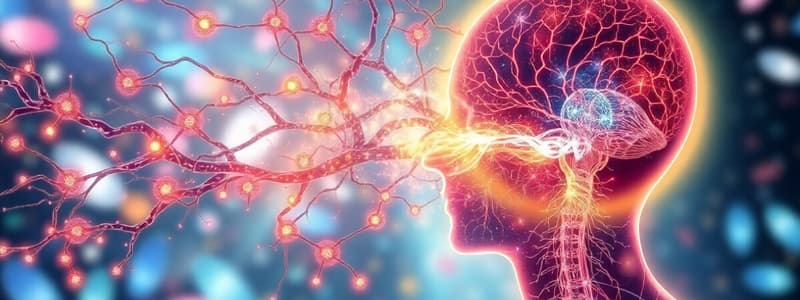Podcast
Questions and Answers
______ is the study of physiological responses to behavioral stimuli mediated through the autonomic nervous system.
______ is the study of physiological responses to behavioral stimuli mediated through the autonomic nervous system.
Psychophysiology
Galvanic skin response (GSR), body temperature, and heart rate are key ______ used in psychophysiological studies.
Galvanic skin response (GSR), body temperature, and heart rate are key ______ used in psychophysiological studies.
measurements
The autonomic nervous system (ANS) is divided into the sensory (afferent) division and the ______ (efferent) division.
The autonomic nervous system (ANS) is divided into the sensory (afferent) division and the ______ (efferent) division.
motor
Within the motor division of the ANS, there are two systems: the somatic nervous system and the ______.
Within the motor division of the ANS, there are two systems: the somatic nervous system and the ______.
The sympathetic division and the parasympathetic division branch out from the ______ nervous system (ANS).
The sympathetic division and the parasympathetic division branch out from the ______ nervous system (ANS).
Increased heart rate and blood pressure are ______ responses mediated through the autonomic nervous system.
Increased heart rate and blood pressure are ______ responses mediated through the autonomic nervous system.
During a stressful event, the sympathetic nervous system triggers a ______ response, increasing heart rate and alertness to facilitate quick reactions.
During a stressful event, the sympathetic nervous system triggers a ______ response, increasing heart rate and alertness to facilitate quick reactions.
Dilation of the pupils and bronchioles/airways are characteristic responses driven by the ______ division of the autonomic nervous system during stress.
Dilation of the pupils and bronchioles/airways are characteristic responses driven by the ______ division of the autonomic nervous system during stress.
The parasympathetic nervous system promotes the ______ response, facilitating digestion and conserving energy.
The parasympathetic nervous system promotes the ______ response, facilitating digestion and conserving energy.
Digestion, defecation, and diuresis, vital for homeostasis and nutrient absorption are primarily regulated by the ______ nervous system.
Digestion, defecation, and diuresis, vital for homeostasis and nutrient absorption are primarily regulated by the ______ nervous system.
Activation of sweat glands, indicative of increased skin conductance, often happens with ______ nervous system activation during stressful situations.
Activation of sweat glands, indicative of increased skin conductance, often happens with ______ nervous system activation during stressful situations.
An increase in heart rate and contraction force, coupled with vasoconstriction, are signs of ______ activation during stress.
An increase in heart rate and contraction force, coupled with vasoconstriction, are signs of ______ activation during stress.
When sympathetic activation causes vasoconstriction in blood vessels to the skin and kidneys, it typically leads to a ______ in skin temperature.
When sympathetic activation causes vasoconstriction in blood vessels to the skin and kidneys, it typically leads to a ______ in skin temperature.
The activation of sympathetic nerves, leading to increased sweat production and skin conductance, is associated with ______.
The activation of sympathetic nerves, leading to increased sweat production and skin conductance, is associated with ______.
In a state of low stress, there is reduced sympathetic nervous system (SNS) response accompanied by an increase in skin ______.
In a state of low stress, there is reduced sympathetic nervous system (SNS) response accompanied by an increase in skin ______.
When skin conductivity decreases, it indicates reduced activation of the sympathetic nervous system (SNS) and increased activity in the ______ nervous system (PNS).
When skin conductivity decreases, it indicates reduced activation of the sympathetic nervous system (SNS) and increased activity in the ______ nervous system (PNS).
While the sympathetic nervous system typically increases heart rate and force of contraction, the ______ nervous system decreases these parameters.
While the sympathetic nervous system typically increases heart rate and force of contraction, the ______ nervous system decreases these parameters.
The ______ of a Galvanic Skin Response (GSR) signal represents the height of the signal, reflecting the intensity of the response.
The ______ of a Galvanic Skin Response (GSR) signal represents the height of the signal, reflecting the intensity of the response.
The ______ in a Galvanic Skin Response (GSR) measurement is the delay, or interval, between a stimulus and the peak of the response.
The ______ in a Galvanic Skin Response (GSR) measurement is the delay, or interval, between a stimulus and the peak of the response.
In calculating heart rate from an electrocardiogram (ECG), the interval between two consecutive R waves ($R-R$) is used to determine ______.
In calculating heart rate from an electrocardiogram (ECG), the interval between two consecutive R waves ($R-R$) is used to determine ______.
Did the subjects’ skin conductance increase or decrease in response to being startled? What does your result suggest is occurring in the skin?
Did the subjects’ skin conductance increase or decrease in response to being startled? What does your result suggest is occurring in the skin?
Was there a noticeable change in the volunteer’s skin temperature during mild
stress? What branch of the autonomic nervous system do your data suggest was active during stress?
Was there a noticeable change in the volunteer’s skin temperature during mild stress? What branch of the autonomic nervous system do your data suggest was active during stress?
Did pulse rate increase or decrease during stress? Explain why physiologically.
Did pulse rate increase or decrease during stress? Explain why physiologically.
n many countries, polygraph (lie detector) results are not admissible as evidence
in a court of law. Based on your results, why do you suppose this is?
n many countries, polygraph (lie detector) results are not admissible as evidence in a court of law. Based on your results, why do you suppose this is?
Flashcards
Psychophysiology
Psychophysiology
The study of physiological responses to behavioral stimuli mediated through the autonomic nervous system.
Sympathetic Responses
Sympathetic Responses
The body's 'fight-or-flight' response, triggered by stress. Increases heart rate, blood pressure and blood supply to the skeletal muscles.
Parasympathetic Responses
Parasympathetic Responses
The body's 'rest-and-digest' response, conserving and restoring energy. Decreases heart rate, airways diameter and pupil diameter.
Stress & Skin Conductance
Stress & Skin Conductance
Signup and view all the flashcards
GSR Amplitude
GSR Amplitude
Signup and view all the flashcards
GSR Latency
GSR Latency
Signup and view all the flashcards
Stress and sweat activity
Stress and sweat activity
Signup and view all the flashcards
Low stress response
Low stress response
Signup and view all the flashcards
Study Notes
- Study notes on Psychophysiology I and Bio 269L
Psychophysiology
- Psychophysiology studies the physiological responses to behavioral stimuli.
- These responses are mediated through the autonomic nervous system.
- Measurements include Galvanic skin response (GSR), also called electrodermal response (EDR), body temperature, and heart rate.
Autonomic Nervous System (ANS) Organization
- The Central Nervous System (CNS) connects to the Peripheral Nervous System (PNS).
- The PNS has sensory (afferent) and motor (efferent) divisions.
- The motor division includes the somatic and autonomic nervous systems.
- The autonomic nervous system consists of the sympathetic and parasympathetic divisions.
Sympathetic Responses
- Stress increases the sympathetic system, leading to a fight-or-flight response.
- Sympathetic responses include dilation of the pupils, increased heart rate and blood pressure, and dilation of the bronchioles/airways.
- Constriction of blood vessels supplying the kidneys and gastrointestinal tract occur.
- Blood supply to the skeletal and cardiac muscles increases.
Parasympathetic Responses
- The parasympathetic system induces a rest-and-digest response.
- Body functions related to digestion, defecation, and diuresis are ares increased.
- Energy is conserved and restored.
- Digestive and urinary functions are stimulated.
- There are "three decreases": heart rate, diameter of airways, and diameter of pupils.
Stress and the Sympathetic Nervous System (SNS)
- Stress leads to a SNS response.
- Sympathetic activation increases sweat gland activity in hands and feet
- Increased sweat on the skin results in increased conductance (μS) or decreased resistance.
- Vasoconstriction of blood vessels decreases blood flow to the skin, which lowers skin temperature.
- Sympathetic activation increases heart rate and contraction force, leading to an increased pulse rate.
Low Stress and the Parasympathetic Nervous System (PNS)
- Low stress results in decreased SNS activity and increased PNS activity.
- Skin conductivity decreases.
- Skin temperature increases.
- Heart rate and force of contractility decrease.
- Low stress decreases SNS activity for conductivity, temperature, heart rate, and force, while increasing PNS activity for heart rate.
Effects of SNS and PNS
- The SNS increases heart rate and force, stimulates sweating, and causes vasoconstriction.
- The PNS decreases heart rate and force.
- The PNS and SNS have no effect on most bodily functions.
Exercise 1: GSR Amplitude and Latency Measurements
- Amplitude is the height of the GSR signal
- Latency is the delay or interval between a stimulus and the peak of the response.
- When placing GSR electrodes on the hand, the hands should be clean, dry, and jewelry should be removed.
Exercise 2: GSR + Skin Temp + Pulse
- Exercise includes data collection related to GSR, Skin Temp, and Pulse
How to Calculate Heart Rate
- Heart rate is calculated using the formula: 60 seconds / R-R Interval = beats per minute.
Next Week: Presentations
- Conducting experiment time: 40 minutes (2 subjects).
- Preparing presentation time: 30 minutes.
- Prepare 3 different graphs for the 3 measurements: GSR, temperature, HR.
- Presentations begin after 1 hour and 15 minutes.
- The presentation should be emailed prior.
- Group participation tables should be completed.
Grading
- A rubric is used to determine the grade, totaling 20 points.
- Pages 6-7 of the provided document outlines the rubric.
- Use a copy of the rubric as a checklist to ensure all components of the assignment are complete.
Studying That Suits You
Use AI to generate personalized quizzes and flashcards to suit your learning preferences.




